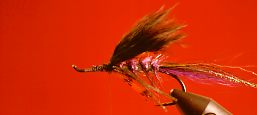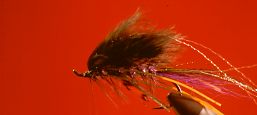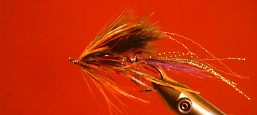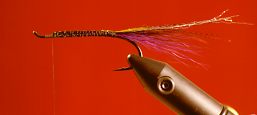
|
|
Step 1:
Cover the hook with tying thread. Tie in a sparse clump of purple polar bear or bucktail. Follow this clump up with a similar amount of black polar bear or bucktail. Try not to stack the tail hair an uneven tail appears more natural. Add a few strands of black and pearlescent Krystal Flash. Stagger cut the Krystal Flash so it shimmers throughout the tail. Finally select a yellow Golden Pheasant feather. Stroke the tips together and tie it in as a tail topping. This topping should extend back about halfway along the tail. The finished tail should be shank length.
|
When
it comes to winter steelhead patterns there are few styles as popular
as prawn imitations. Favorites such as the General Practitioner
and the Squamish Poacher immediately come to mind. Conventional
gear fishers know the value of ghost shrimp as bait. On the West
Coast many fly fishers use prawn imitations to represent ghost shrimp
or "bugs" as there are affectionately called. Tyson Gogel is one
such fly fisher. A member of the Totem Fly Fishers and full time
employee of Ruddick's fly shop Tyson has devoted himself to the
pursuit of the anadromous steelhead. Every year Tyson wields his
two handed Spey rods for steelhead on rivers such as the Dean, Squamish,
Thompson and those of the Skeena drainage.
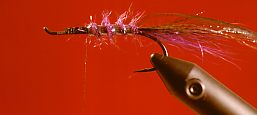
|
|
Step 2:
Take a large black saddle feather hold it by the tip with
the shiny side facing towards you. Strip the barbules from
the left side of the feather. Tie in the prepared saddle hackle
tip first followed by a length of pearlescent Mylar. Form
a dubbing loop insert the dubbing and twist it tight. Wind
the dubbing noodle forward and cover the rear half of the
hook. Be careful not to go past the halfway point or a crowed
fly will result. Spiral the pearlescent Mylar rib forward
in even open turns. Tie it off at the midpoint and trim the
excess.
|
As
with other innovative steelhead fly fishers Tyson developed his
own fly patterns including a number of prawn or ghost shrimp imitations.
When I asked for a sample of his work Tyson was quick to reach for
his Marabou Prawn. A pattern born out of Tyson's desire for a dark
pattern that provided a large silhouette. The Marabou Prawn is a
busy design reminiscent of a General Practitioner with a few modern
materials thrown in for good measure.
The
tail is a mixture of black and purple polar bear. Bucktail makes
a great substitute. For added sparkle and glitter Tyson includes
a sparse amount of black and pearlescent Krystal Flash. A single
yellow Golden Pheasant tail feather tops the tail section providing
a traditional touch. The body section is crowded; Tyson stresses
not to overdress the pattern despite its complexity, as this tends
to kick the fly over onto its side. As with the General Practitioner
the body is made up of two identical sections consisting of a dubbed
body ribbed with large pearlescent Mylar followed up with a black
saddle hackle. Tyson's favorite material for the body is Poul Jorgenson's
Purple Haze SLF a bright mixture of many colors. At the mid point
on the fly Tyson incorporated dyed orange Golden Pheasant tippet
spread around the hook shank. For movement a single clump of black
marabou extending back onto the tail forms a mid point wing. Silicone
rubber legs provide additional jiggle while adding a touch of nastiness.
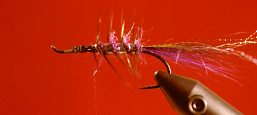
|
|
Step 3: Palmer the black saddle feather
forwards along the back edge of Mylar rib to help protect
the fragile feather stem.
|
Tyson
prefers a combination of black and purple legs while I like the
Halloween look of black and orange. Vary the leg length so the fly
pulses throughout. With the rear body complete make an identical
second body section. It is critical not to let the rear section
go past the halfway point or you'll quickly run out of room. Complete
the fly by adding two more pairs of rubber legs, another black marabou
wing, and two long strands of pearlescent Krystal Flash for the
antenna. Two bright red golden pheasant rump feathers form a finishing
hackle. As a bright alternative substitute the black wing for one
of burgundy marabou. Tyson's favorite size range runs from #6 through
2/0. As a change from traditional steelhead hooks Tyson also ties
the Marabou Prawn using a split body Waddington style and 25-45
millimeter metal tubes. The tube fly version is Tyson's favorite
when conditions dictate a fly with a huge silhouette.
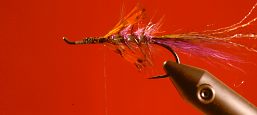
|
|
Step 4: Take a dyed orange Golden Pheasant
tipper feather trim out the tip section and remove the unbarred
portions of the lower feather. Tie the feather in place along
the top portion of the hook so the tips extend back to the
tail if possible. Massage the feather so the tips radiate
and encompass the upper half of the fly. Repeat this process
tying in a second Golden Pheasant tippet feather along the
underside of the hook.
|
Tyson
uses a two handed rod for his steelhead fishing in conjunction with
5 to 30 foot Type IV through VI sink tips depending upon conditions.
Using a traditional down and across presentation Tyson systematically
covers likely looking water in the hopes of dredging up steelhead
from their sullen lies. Mend the line as necessary to ensure a thorough
deep drift. Swing the fly tight the bank and leave it hang there
for a few seconds. Steelhead are known for following a fly right
to the shore before striking.
Marabou Prawn
-
Hook: Tiemco 7999 #6-2/0
-
Thread: Black 6/0
-
Tail: Black Polar Bear or Bucktail Over Purple Polar Bear or Bucktail.
Mix in a Sparse amount of Black and Pearlescent Krystal Flash.
Top with a single Yellow Golden Pheasant Feather Flashabou
-
Rear Body: Purple Haze SLF Dubbing ribbed
-
Section: With large pearlescent Mylar and Palmered with a black
saddle feather
-
Mid Body: Dyed Orange Golden Pheasant Tippets
-
Section: fanned around the rear body section. Two Pairs of Silicone
legs are tied in on each side Of the body.
-
Mid Wing: Black or Burgundy Marabou
-
Front Body: Same combination as the rear body section Section
-
Front Legs: Two pairs of silicone rubber legs
-
Front Wing: Black or Burgundy Marabou
-
Antenna: Two long strands of Pearlescent Krystal Flash
-
Hackle: Two Large Bright Red Golden Pheasant Rump Feathers
|
|
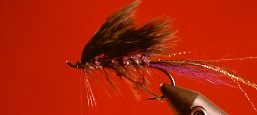
|
|
Step 5:
Double a silicone rubber leg strand around the tying thread.
Slide it into position on the far side of the hook and secure
in place. Do the same for the near side pair of legs. Trim
the legs so they extend onto the tail. Strip a clump of
black marabou fibers from a marabou plume and tie them in
place as a wing. Chose a bushy marabou feather for the illusion
of bulk without volume. Wooly Bugger marabou works great
for this.
|
Step 6: Prepare the front body section
of dubbing, black saddle and a pearlescent Mylar rib in
the same fashion as the rear section. With the front section
completed tie in a second wing of black marabou. The tips
of the second wing should extend a least halfway up the
first wing.
|
|
|
|
|
Step 7: Double a single strand of pearlescent
Krystal Flash around the tying thread and tie it into position
on the top of the hook. Trim these Krystal Flash antennae
about equal with the end of the tail. Tie in additional
silicone rubber legs along each side of the fly in the same
manner as those tied in at the mid shank. Let these legs
trail back to the end of the tail. The varied leg length
provides varied movement and life.
|
Step 8: Select two red Golden Pheasant
rump feathers. Lay them one on top of each other shiny side
to dull side and strip away the flue and fluff from the
base of the feathers. Tie the feathers in by their tips
to reduce bulk wet fly style with the shiny side of the
feathers facing outwards. Wind the hackle 2 to 3 times tie
off and trim the excess. Spin the tying thread counter clockwise
to untwist it and build a neat head sweeping the hackles
back in the process. Whip finish and apply head cement.
|

|








